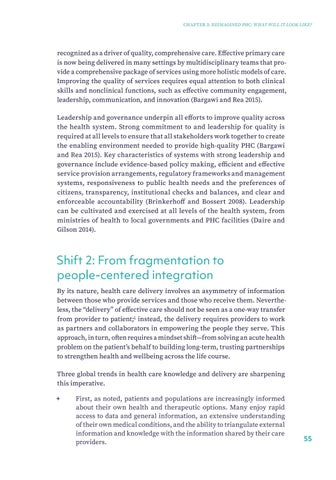CHAPTER 3: REIMAGINED PHC: WHAT WILL IT LOOK LIKE?
recognized as a driver of quality, comprehensive care. Effective primary care is now being delivered in many settings by multidisciplinary teams that provide a comprehensive package of services using more holistic models of care. Improving the quality of services requires equal attention to both clinical skills and nonclinical functions, such as effective community engagement, leadership, communication, and innovation (Bargawi and Rea 2015). Leadership and governance underpin all efforts to improve quality across the health system. Strong commitment to and leadership for quality is required at all levels to ensure that all stakeholders work together to create the enabling environment needed to provide high-quality PHC (Bargawi and Rea 2015). Key characteristics of systems with strong leadership and governance include evidence-based policy making, efficient and effective service provision arrangements, regulatory frameworks and management systems, responsiveness to public health needs and the preferences of citizens, transparency, institutional checks and balances, and clear and enforceable accountability (Brinkerhoff and Bossert 2008). Leadership can be cultivated and exercised at all levels of the health system, from ministries of health to local governments and PHC facilities (Daire and Gilson 2014).
Shift 2: From fragmentation to people-centered integration By its nature, health care delivery involves an asymmetry of information between those who provide services and those who receive them. Nevertheless, the “delivery” of effective care should not be seen as a one-way transfer from provider to patient;1 instead, the delivery requires providers to work as partners and collaborators in empowering the people they serve. This approach, in turn, often requires a mindset shift—from solving an acute health problem on the patient’s behalf to building long-term, trusting partnerships to strengthen health and wellbeing across the life course. Three global trends in health care knowledge and delivery are sharpening this imperative. ++
First, as noted, patients and populations are increasingly informed about their own health and therapeutic options. Many enjoy rapid access to data and general information, an extensive understanding of their own medical conditions, and the ability to triangulate external information and knowledge with the information shared by their care providers.
55


